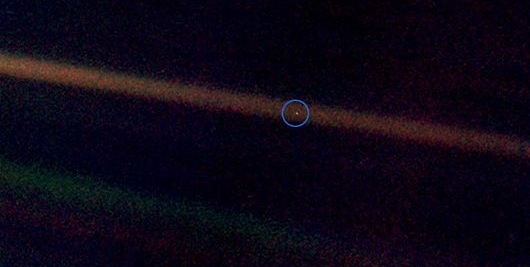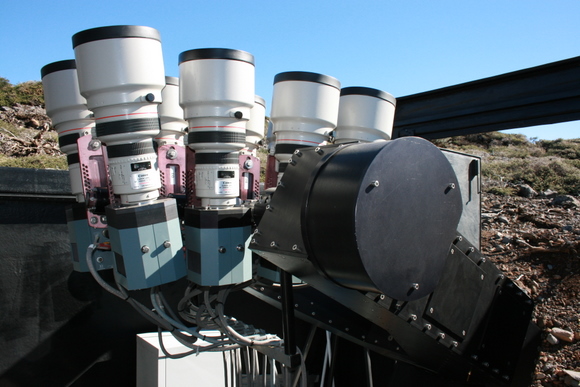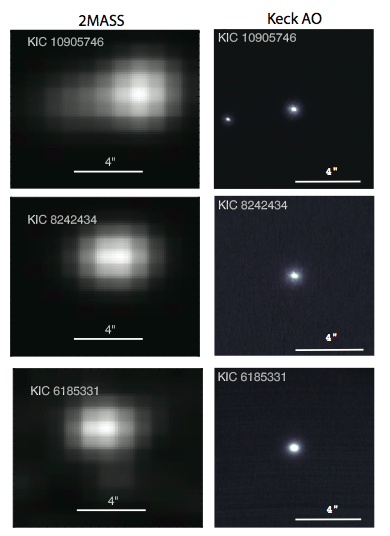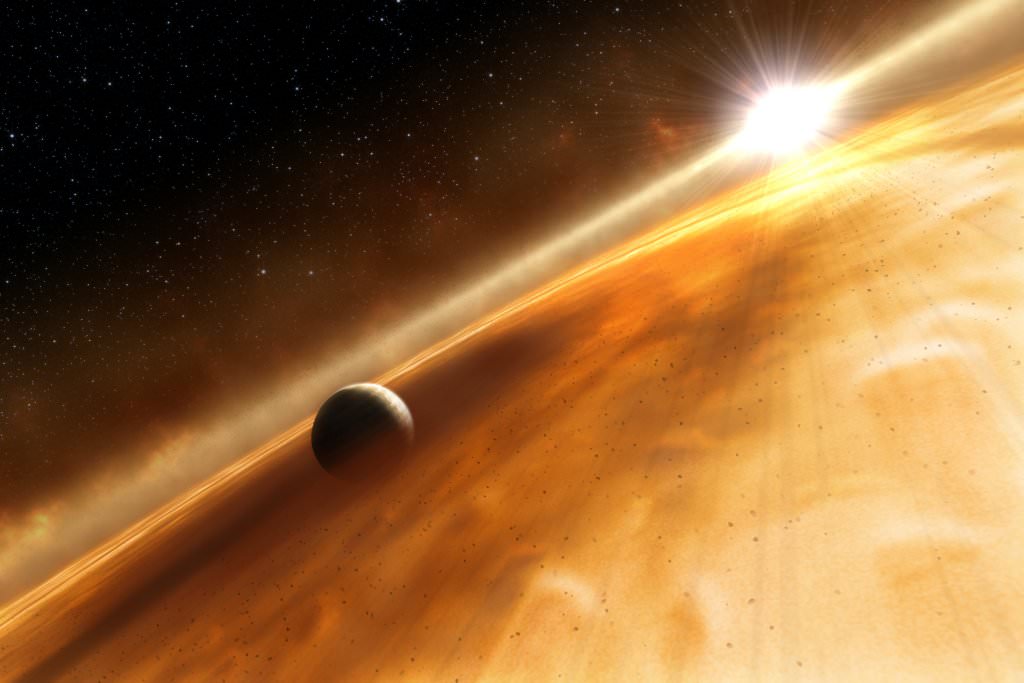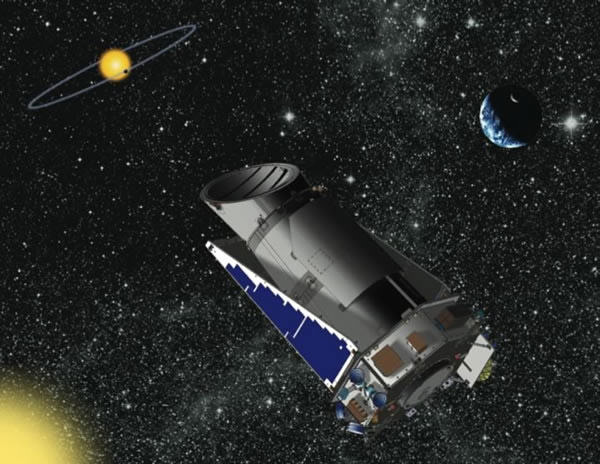A new NOVA show airs tonight (October 19) in the US on public television, called “Finding Life Beyond Earth.” It includes interviews with many big names in planetary science and like any NOVA show, should be excellent. PBS has a great website that goes along with the show, and for those of you that don’t live in the US or get a public television station, PBS usually posts the videos of NOVA shows online later. Above is a trailer for the show. Check your local listings for when it will air; if you miss it first time around, local stations will sometimes re-air the show during the middle of the night!
Evidence of a Late Heavy Bombardment Occuring in Another Solar System
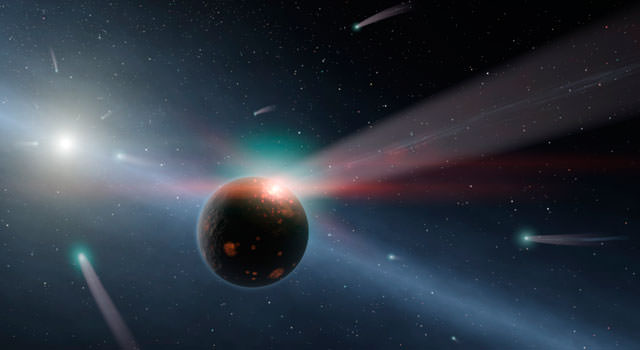
[/caption]
Planetary scientists have not been able to agree that a turbulent period in our solar system’s history called the Late Heavy Bombardment actually occurred. But now, using observations from the Spitzer Space Telescope, scientists have detected activity resembling a similar type of event where icy bodies from the outer solar system are possibly pummeling rocky worlds closer to the star. This is the first time such activity has been seen in another planetary system.
“Where the comets are hitting the rocky bodies is in the habitable zone around this star, so not only are life-forming materials possibly being delivered to rocky worlds, but also in the right place for life as we know it to grow,” said Carey Lisse, senior research scientist at the Johns Hopkins University Applied Physics Laboratory. “This is similar to what happened to our own solar system during the Late Heavy Bombardment.”
Lisse spoke to journalists in a conference call from the Signposts of Planets meeting taking place at Goddard Space Flight Center this week.
Spitzer observations showed a band of dust around the nearby, naked-eye-visible star called Eta Corvi, located in the constellation Corvus in northern sky. Within the band of warm dust, Spitzer’s infrared detectors saw the chemical fingerprints of water ice, organics and rock, which strongly matches the contents of an obliterated giant comet, suggesting a collision took place between a planet and one or more comets. Also detected was evidence for flash-frozen rocks, nanodiamonds and amorphous silica.
This dust is located 3 AU away from Eta Corvi, which is the “habitable zone” around that star, and is close enough to the star that Earth-like worlds could exist. Lisse said although it hasn’t been confirmed, researchers think there is a Neptune-like world and at least two other planets in this system. A bright, icy Kuiper Belt-like region located 3-4 times farther out than our own Kuiper Belt was discovered around Eta Corvi in 2005.
“This is very possibly a planet-rich system,” Lisse said.
The light signature emitted by the dust around Eta Corvi also resembles meteorites found on Earth. “We see a match between dust around Eta Corvi and the Almahata Sitta meteorites, which fell to Earth in Sudan in 2008,” Llisse said. “We can argue that the material around Eta Covi is rich in carbon and water, things that help life grow on Earth.”
The Eta Corvi system is approximately one billion years old, which the research team considers about the right age for such a bombardment.
No asteroidal dust was found in the disk around Eta Corvi.
“Asteroidal dust would look like it had been heated, and chemically and physically altered, and most of the water and carbon would be gone,” Lisse said. “This dust is very rich in water and carbon and the rocky components are very primitive and un-altered.”
Most planetary formation theories can’t account for such an intense period of bombardment in our own solar system so late in its history, but the Nice Model proposed in 2005 suggests the Late Heavy Bombardment was triggered when the giant planets in our solar system— which formed in a more compact configuration – rapidly migrated away from each other (and their orbital separations all increased), and a disk of small asteroids and comets that lay outside the orbits of the planets was destabilized, causing a sudden massive delivery of asteroids and comets to the inner solar system. The barrage scarred the Moon and produced large amounts of dust.
“We can see the process of this happening at Eta Corvi and can learn more about our own solar system, since we can’t go back in time,” Lisse said. “It’s very possible that the rain of comets and Kuiper Belt Objects brought life to Earth.”
Lisse and his team are not sure if one big comet or lots of smaller comets are pummeling the inner solar system. “It is probably many bodies, but we only see the effects of the largest ones,” he said.
Could this be an indication that a Late Heavy Bombardment happens in many solar systems? “It’s not clear whether this is an atypical system, but we do know of one other possible system where it could be happening,” Lisse said in response to the question posed by Universe Today. “I think this is a rare event, which might mean that life is rare if you need a Late Heavy Bombardment for life to happen.”
Lisse said the reason they studied this star was the earlier detection of the Kuiper Belt-like region around Eta Corvi. “We knew it was an exceptional system from previous infrared sky surveys and the large bright Kuiper Belt was just the tip of the iceberg,” Lisse said. “This system was shouting, ‘I’m something extraordinary, come figure out my mystery!”
Paper: Spitzer Evidence for a Late Heavy Bombardment and the Formation of Urelites in Eta Corvi at ~1 Gyr
Source: Signposts of Planets conference call, JPL Press release
What Would Earth Look Like from a Distant Star?
As the number of discovered extrasolar planets grows, astronomers begin looking at the next step: finding rocky Earth-like planets. In addition, astronomers would ideally like to block out the parent star and detect some of the reflected glow from the planet’s atmosphere in an attempt to characterize the chemical makeup. But what would an “Earth-like” planet’s reflected light look like? To answer this, a new paper explores what Earth should have looked like at various points in our planet’s history.
Currently, astronomers have a good understanding on how our planet reflects light. Even before satellites were launched that could observe this directly, we could see the reflected light from our home on the moon, an effect known as “Earthshine”. The amount of light reflected depends on what’s on the surface.
The paper considers five different types of reflecting materials. Water and vegetation tend to be strong absorbers of light at visible and ultraviolet wavelengths whereas ice and deserts are highly reflective. The amount of cloud cover, which also reflects a good deal of light, is the fifth.
With the modern Earth, our planet currently reflects about 32% of all incoming light. This changes by a few percent depending on the season, depending mostly on the amount of cloud cover.
This new study also analyzes what the amount of reflected light should have been for Earth, known as its albedo, during four other historical periods: the Late Cretaceous (90 million years ago), the Late Triassic (230 My ago), the Mississippian (340 My ago), and the Late Cambrian (500 My ago).
Using simulations based on the various surface features, the team from the Instituto de Astrofísica de Canarias owned by Spain, the team reconstructed the expected amount of cloud cover for these various epochs to consider their contributions to the overall albedo.
In general, the historical periods had strikingly similar amounts of reflectiveness due to “similar ocean-land-vegitation distribution” as well as similar distributions of continents between hemispheres and most deserts in low latitudes. The exception to this, was the Late Cambrian. While the average was only slightly higher, this period varied depending on which portion of the Earth was viewed.
At that time, the original supercontinent, Pangea was in the process of breaking up. They were still clustered and almost exclusively in the southern hemisphere. The sea levels were also significantly higher meaning a larger portion of land was submerged, covered by the non-reflective water. Lastly, most of the life was still concentrated in the oceans. Since it had not yet advanced to land, it is expected that the surface was mostly rocky desert terrain which would have high reflectivity. During the times when the breaking up supercontinent was facing an observer, the albedo would jump to as much as 37% only to sink to 32% when it rotated from view.
The team suggests that such a variation may allow astronomers to determine the rotation rates of planets in the future. In an ideal situation, it may even give clues to the geographical arrangement of continents.
High Precision Study of Exoplanet WASP 10b
[/caption]
Originally discovered by the Wide Angle Search for exoPlanets (WASP) survey in 2008, the eclipsing exoplanet WASP 10b has been reluctant to allow its properties to be pinned down. While its mass has been pinned down by two independent groups to right around 3 times the mass of Jupiter, the radius and thus, the overall density which gives hints at the composition, has been harder to determine. Groups have also reported oddities in the timing of the eclipses that may hint at the presence of another planets whose gravitational tug is changing the orbit of 10b. A new study attempts to answer these questions with high precision observations from the Spanish 2.2 meter Calar Alto Observatory.
The new study, led by astronomers from Nicolaus Copernicus University in Poland, is the first of WASP 10b to take into account the effects of star spots. Since the host star is a K-dwarf such spots should be common. When such spots are present, the planet can eclipse them as well, making the overall brightness increase temporarily. This apparent change in the brightness of the star makes small changes in how astronomers would determine the overall brightness of the star. This brightness is used to determine the properties of the star, such as its radius, which also factor into determining the radius of the planet. As such, these spots should be taken into account for the most accurate understanding possible.
The team observed four transits of the planet in late 2010. In that time, star spots were present for three of the four transits. With the spots subtracted out, the team agreed with previous estimates of mass, but found an even lower value for the radius than either of the previous studies. Their value was only a few percent wider than Jupiter despite being three times as massive. While this doesn’t make WASP 10b most dense planet known, it does rank among the top contenders.
These results have implications for how planets may form in general. Since WASP 10 is estimated to be a relatively young star, it would imply that the major planet formed a rocky core early on and that it wasn’t deposited later through collisions. The team estimates that it would require a total mass for the core of roughly 300-400 times the mass of Earth.
When the team added their new data to previous studies of the system, they found that the timing of the transits have continued to change and these changes could not be the product of other effects, such as star spots on the limb of the star altering the shape of the light curve. As such, they note that “this finding supports a scenario in which the second planet perturbs the orbital motion of WASP 10b.”
Big Find: Citizen Scientists Discover Two Extrasolar Planets
[/caption]
Hip-hip hooray for citizen scientists! The first two exoplanet candidates have been identified by members of the public through the citizen science project Planet Hunters. The project, which began in December 2010, uses public archive data from the planet-hunting Kepler mission, and excitingly, the planets were found within the first month after the project began. One planet is potentially a rocky Earth-like planet, while the other is likely a gas-giant like Jupiter.
“I think it’s truly amazing that someone sitting at home at their computer was the first to know that a star somewhere out there in our Milky Way likely has a companion,” said Meg Schwamb, a Yale University researcher and Planet Hunters co-founder.
By all accounts, the Kepler mission has been a spectacular success – with over 1,200 planet candidates detected so far– and the data obtained by the spacecraft has been a treasure trove for scientists. But over 40,000 web users from around the world have been helping professional astronomers analyze the light from 150,000 stars in the hopes of discovering planets – and especially Earth-like planets — orbiting around them.
“These planet candidates just show what wealth of interesting gems still remaining to be found in the Kepler data,” Schwamb told Universe Today. She added that for the science team, the Planet Hunters project was somewhat of a gamble, as no one was sure human eyes would be able to spot things possibly missed by automated routines.
“The gamble paid off, and we’re all very excited about the discovery of these planet candidates,” she said. “These candidates have demonstrated the truly amazing power of human pattern recognition. Planet Hunters doesn’t replace the great work and the analysis being done by the Kepler team. But it has proven itself to be a valuable and complementary tool in the search for extrasolar planets.”
The Planet Hunters team sent the top 10 candidates found by the citizen scientists to the Kepler team, and two of the planets have survived the initial checks for false-positives, whether they are masquerading as eclipsing binaries, for example. Scientists used the Keck Observatory in Hawaii and the Two Micron All Sky Survey (2MASS) at Caltech to analyze the host stars and determined that two of the 10 met their criteria for being classified as planet candidates.
The two candidates were flagged as potential planets by several dozen different Planet Hunters users, as the same data are analyzed by more than one user.
The two candidate planets orbit their host stars with periods ranging from 10 to 50 days — much shorter than the 365 days it takes the Earth to orbit the Sun — and have radii that range in size from two-and-a-half to eight times Earth’s radius. Despite one planet having the potential to be a rocky world, it does not lie in the so-called “habitable zone” where liquid water, and therefore life as we know it, could exist.
Schwamb said to confirm a transiting planet, the team scientists will look at the radial velocities to measure the wobble of the star back and forth caused by the orbiting body.
“This allows you to get the mass of the orbiting companion,” she said. “Kepler was always intended to be a statistical mission. The majority of the over 1,200 Kepler planet candidates and the planet candidates found by Planet Hunters will not be confirmed with radial velocity measurements either because the star is too faint or the radial velocity signal caused by the orbiting planet would be smaller than the current sensitivity limits of the world’s best spectrographs. If it’s possible that we can confirm the presence of these planets with radial velocities measured on the Keck telescopes, we will definitely try.”
As of now, the Planet Hunter scientists, which also includes Yale astronomer Debra Fisher, say there is at least a 95% chance that these two candidates are bona fide planets.
Spurred by success, the Planet Hunters citizen scientist are now sifting through a new round of publicly available data from the Kepler mission in hopes of finding even more planets. “This is what we found after just a preliminary glance through the first round of Kepler data,” Fischer said. “There’s no doubt that, with each new round of data, there will be more discoveries to come.”
Read the team’s paper here. It has been submitted to the journal Monthly Notices of the Royal Astronomical Society.
‘Invisible’ World Discovered Around a Distant Star

[/caption]
There’s a planet out there playing a game of ‘doorbell ditch’ with astronomers. Scientists can’t see this distant world, but they know it’s there because its gravity is having a noticeable effect on the orbit of a neighboring planet.
“It’s like having someone play a prank on you by ringing your doorbell and running away,” said astronomer Sarah Ballard of the Harvard-Smithsonian Center for Astrophysics (CfA), lead author on a new paper published in the The Astrophysical Journal. “This invisible planet makes itself known by its influence on the planet we can see.”
The planetary system of the visible and stealthy planets was discovered by the Kepler spacecraft, and the two worlds orbit a Sun-like star named Kepler-19. The system is located 650 light-years from Earth in the constellation Lyra. The 12th-magnitude star is well placed for viewing by backyard telescopes on September evenings in the northern hemisphere.
Launched in 2009, NASA’s Kepler spacecraft hunts for extra-solar planets around stars other than our Sun by watching for planets orbiting in front of their stars. These “transiting” planets block some of the starlight, and that’s how astronomers “see” that a planet is there.
However, the planet and star must line up exactly for us to see a transit.
That was the case for the first planet, Kepler-19b. It transits its star every 9 days and 7 hours, at a distance of 8.4 million miles from the star, where it is heated to a temperature of about 900 degrees Fahrenheit. The great thing about transits is that astronomers can deduce the planet’s physical size: the greater the dip in light, the larger the planet relative to its star. Kepler-19b has a diameter of 18,000 miles, making it slightly more than twice the size of Earth. It may resemble a “mini-Neptune,” however its mass and composition remain unknown.
If Kepler-19b were alone, each transit would follow the next like clockwork. Instead, the transits come up to five minutes early or five minutes late. Such transit timing variations show that another world’s gravity is pulling on Kepler-19b, alternately speeding it up or slowing it down.
If this sounds somewhat familiar, the planet Neptune in our own solar system was discovered similarly. Astronomers tracking Uranus noticed that its orbit didn’t match predictions. They realized that a more distant planet might be nudging or pulling on Uranus and calculated the expected location of the unseen world. Telescopes soon observed Neptune near its predicted position.
But this is the first time this method has been used to find a previously unknown planet in another solar system. Astronomers say no other current technique we have could have found the unseen companion.
“This method holds great promise for finding planets that can’t be found otherwise,” stated Harvard astronomer and co-author David Charbonneau.
So far, astronomers don’t know anything about the invisible world Kepler-19c, other than that it exists. It weighs too little to gravitationally tug the star enough for them to measure its mass. And Kepler hasn’t detected it transiting the star, suggesting that its orbit is tilted relative to Kepler-19b.
“Kepler-19c has multiple personalities consistent with our data. For instance, it could be a rocky planet on a circular 5-day orbit, or a gas-giant planet on an oblong 100-day orbit,” said co-author Daniel Fabrycky of the University of California, Santa Cruz (UCSC).
The Kepler spacecraft will continue to monitor Kepler-19 throughout its mission. Those additional data will help nail down the orbit of Kepler-19c. Future ground-based instruments like HARPS-North will attempt to measure the mass of Kepler-19c. Only then will we have a clue to the nature of this invisible world.
Source: Harvard Smithsonian CfA
Where’s the Debris for Transiting Planets?
For many exoplanet systems that have been discovered by the radial velocity method, astronomers have found excess emission in the infrared portion of the spectrum. This has generally been interpreted as remnants of a disk or collection of objects similar to our own Kupier belt, a ring of icy bodies beyond the orbit of Pluto. But as Kepler and other exoplanet finding missions rake in the candidates though transits of the parent star, astronomers began noticing something unusual: None of the exoplanet systems discovered through this method were known to have debris disks. Was this an odd selection effect, perhaps induced by the fact that transiting planets often orbit close to their parent stars, making them more likely to pass along the line of sight which could in turn, betray different formation scenarios? Or were astronomers simply not looking hard enough? A recent paper by astronomers at the Astrophysikalisches Institut in Germany attempts to answer that question.
In order to do so, the team compared the (at the time) 93 known transiting exoplanets to stars for which archival data was available through infrared missions such has IRAS, ISO, AKARI, and WISE. The team then searched the data looking for a previously unrecognized bump in the emission in the infrared. Many of the stars they searched were faint, due to distance, so most of the IR telescopes did not have images with sufficient depth to draw much in the way of conclusions. Between IRAS, ISO, Spitzer, and AKARI, the team was only able to examine three stars, and all of those came from Spitzer observations.
The most plentiful return came from the WISE telescope which had 53 entries that overlapped with known transiting systems, one of which was excluded due to image defects. From these 52 candidates, the team found four that may have contained excess emission. To follow up, the team added observations from other observatories that lied in the near infrared (the 2MASS survey) and the visual portion of the spectrum. This allowed them to build a more complete picture of the brightness of the stars at various wavelengths which would make the excess stand out even more. While all four systems deviated from an ideal blackbody in the portion of the spectrum expected for a debris disk, only two of them, TrES-2, and XO-5, did so in a manner that did so in a statistically significant manner.
While this study shows that debris disks are possible around transiting stars, it was only able to confirm their presence in two stars out of 52, or just under 4% of their sample. But how does that compare to systems discovered by other methods? One of the studies cited in the paper used a similar method of comparing archival data from IR observatories to known exoplanet system discovered by other methods in 2009. In this study, the team found debris disks around 10 of the 150 planet-bearing stars, which is roughly 7%. Due to the low return rate on both of these studies, the inherent uncertainty puts these two figures within a plausible range of one another, but certainly, more studies will be in order in the future. They will help astronomers determine just what difference exists, if any, as well as giving more insight into how planetary system form and evolve.
Coming To A Solar System Near You… Super-Earth!
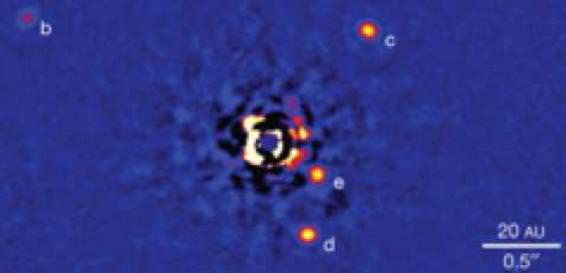
[/caption]
It is our general understanding of solar system composition that planets fall into two categories: gas giants like Jupiter, Saturn, Neptune and Uranus… and rocky bodies that support some type of atmosphere like Earth, Mars and Venus. However, as we reach further into space we’re beginning to realize the Solar System is pretty unique because it doesn’t have a planetary structure which meets in the middle. But just because we don’t have one doesn’t mean they don’t exist. As a matter of fact, astronomers have found more than 30 of them and they call this new class of planet a “Super-Earth”.
“Super-Earths, a class of planetary bodies with masses ranging from a few Earth-masses to slightly smaller than Uranus, have recently found a special place in the exoplanetary science.” says Nader Haghighipour of the Institute for Astronomy and NASA Astrobiology Institute, University of Hawaii. “Being slightly larger than a typical terrestrial planet, super-Earths may have physical and dynamical characteristics similar to those of Earth whereas unlike terrestrial planets, they are relatively easier to detect.”
Having a super-Earth in the neighborhood opens the avenue towards habitability. Chances are planets of this type have a dynamic core and are able to maintain a type of atmosphere. When combined with being within the habitable zone of a host star, this raises the bar towards possible life on other planets.
“It is important to note that the notion of habitability is defined based on the life as we know it. Since Earth is the only habitable planet known to humankind, the orbital and physical characteristics of Earth are used to define a habitable planet.” says Haghighipour. “In other words, habitability is the characteristic of an environment which has similar properties as those of Earth, and the capability of developing and sustaining Earthly life.”
But being a super-Earth means that there is a lot more going on than just being in the zone. To qualify it must meet three requirements: its composition, the manifestation of plate tectonics, and the presence of a magnetic field. For the first, the presence of liquid water is a high priority. In order to determine this possibility the values of its mass and radius have to be known. To date, two super-Earth planets for which these values have been determined – CoRoT-7b and GJ 1214b – have given us fascinating numerical modeling to help us better understand their composition. Plate tectonics also plays a role through geophysical evolution – just as the presence of a magnetic field has been considered essential for habitability.
“Whether and how magnetic fields are developed around super-Earths is an active topic of research.” notes Haghighipour. “In general, in order for a magnetic field to be in place around an Earth-like planet, a dynamo action has to exist in the planet’s core.”
Last, but not least, comes an atmosphere – the “presence of which has profound effects on its capability in developing and maintaining life.” From its chemical properties we can derive the “planet’s possible biosignatures” as well as the chemicals which formed it. Atmosphere means environment and all of this leads back to being within a habitable zone and of sufficient gravity to keep atmospheric molecules from escaping. Says Haghighipour, “It would not be unrealistic to assume that super-Earths carry gaseous envelopes. Around low-mass stars, some of such atmosphere-bearing super-Earths may even have stable orbits in the habitable zones of their host stars.”
Has a super-Earth been detected? You betcha’… and studied right down to its spectral signature. “The recently detected super-Earth GL 581 g with its possible atmospheric circulation in the habitable zone of its host star may in fact be one of such planets.” says Haghighipour. “More advanced telescopes are needed to identify the biosignatures of these bodies and the physical and compositional characteristics of their atmospheres.”
Further Reading: Super-Earths: A New Class of Planetary Bodies.
Two More Kepler Planets Confirmed
[/caption]
Hot on the heels of confirming one Kepler planet, the Hobby-Eberly Telescope announces the confirmation of another planet. Another observatory, the Nordic Optical Telescope, confirms its first Kepler planet as well, this one as part of a binary system and providing new insights that may force astronomers to revisit and revise estimations on properties of other extrasolar planets.
The first reported of these planets was the announcement from the Nordic Optical Telescope of the confirmation of Kepler 14b. The team estimates the planet to be eight times the mass of Jupiter. It orbits its parent star in a short 7 days, putting this object into the class of hot Jupiters. As noted above, the star is in a binary system with the second star taking some 2,800 years to complete one orbit.
In the announcement the team analyzed the data taking into consideration an effect that has been left out of previous studies of extrasolar planets. The team found that the glare from the nearby star in the binary orbit spilled over onto the image of the star around which the planet orbited. This extra light would dilute the eclipse caused by the planet and subsequently, changed the estimations of the planets properties. The team reported that not correcting for this light pollution, “leads to an underestimate of the radius and mass of the planet by 10% and 60%, respectively.” While this consideration would only apply for planets orbiting stars that were in binary systems, or line of sight double stars, the Kepler 14 system did not appear to be a binary system without high resolution imaging from the Palomar Observatory. This begs the question of whether or not any of the other 500+ known extrasolar planets are in similar systems that have not yet been resolved and whether their parameters may need revision.
The next planet, reported at the end of July, has been dubbed Kepler 17b. Again, this planet falls into the category of Hot Jupiters, although this one is only two and a half time times the mass of Jupiter. It orbits a star very similar the Sun in mass and radius, although expected to be somewhat younger. The observations of the star outside of planetary transits revealed a good deal of activity with temporary dips that did not persist on a regular basis like the signal from the planet. Such variance is likely due to stellar activity and Sunspots and allowed the team to reveal more information about the planet.
Because the planet could also eclipse starspots, it created a stroboscopic effect and the team confirmed the planet orbits in the same direction as the star spins. This is notable since several planets are known to have retrograde orbits.
Do Planets Rob Their Stars of Metals?
[/caption]
It has been known for several years that stars hosting planets are generally more rich in elements heavier than hydrogen and helium, known in astronomy as “metals”. These heavy elements help to form the cores of the forming planets and accelerate the formation process. However, a new study has helped to suggest that the opposite may also be true: Planets may make their host stars less metal rich than they should otherwise be.
The new research is led by Ivan Ramirez at the Carnegie Institution for Science. In it, the team analyzed the unusual exo-planetary system 16Cygni. The star system itself is a triple star system composed of two stars similar to the sun (A and B) as well as a red dwarf (C). The solar A star and the red dwarf form a tight binary system with the sun-like B star in a wider orbit of nearly 900 AU. 16CygniB was discovered to be host to a Jovian planet in 1996 making it one of the first systems known to contain an extrasolar planet.
The study analyzed the spectra of the two solar type stars and found that the one around which the planet orbits was notably lower in metals than the one in the binary orbit with the red dwarf. Because both stars should have formed from the same molecular cloud astronomers assume their initial compositions should be identical. Since both are similar masses, they should also have evolved similarly in their main-sequence life which should rule out divergence in their chemical fingerprints.
Similar properties have been noted in a 2009 paper by astronomers at the university of Porto in Portugal. In that study, the team compared our own Sun to other stars of similar composition and age. They discovered that the Sun had an odd feature: It was notably depleted in elements known as refractory metals when compared to volatile elements with low melting and boiling temperatures. The team suggested that those missing elements may have been stolen by forming planets. The newer study makes the same proposition.
Both teams note that the effect is not conclusive. They consider that 16CygA may have been polluted by heavy elements, possibly by the accretion of a planet or similar material. However, they note that if this was the case, they should also expect to see an additional amount of lithium. Yet the lithium abundance for the two stars match. The 2009 paper considers similar cases. They consider that the solar nebula may have been seeded by a nearby supernova that would enhance the abundances, but the enhanced elements do not seem to match the expected productions for any type of supernova. Still, with such a small number of systems for which this effect has been discovered, such cases of special pleading are still within the realm of statistical possibility. Future work will undoubtedly search for similar effects in other planetary systems. If confirmed, such elemental oddities could be considered as a sign of planetary formation.

